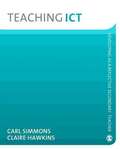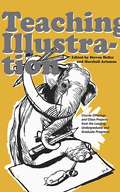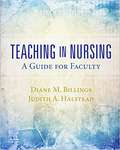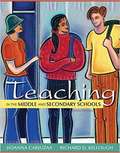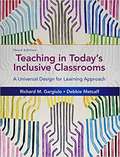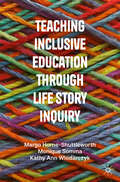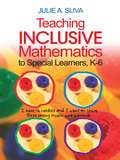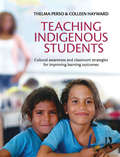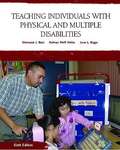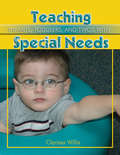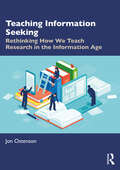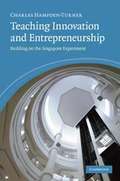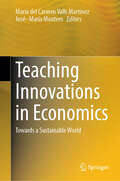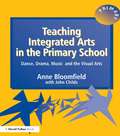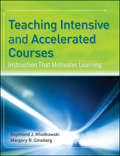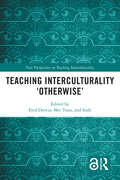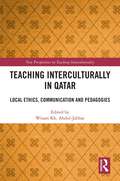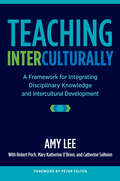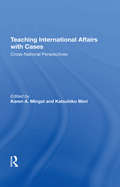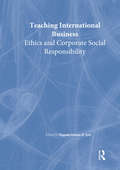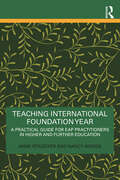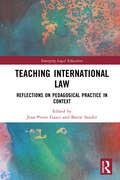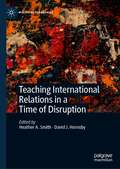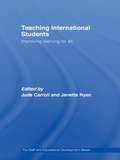- Table View
- List View
Teaching ICT
by Mrs Claire Hawkins Carl SimmonsReflective practice is at the heart of effective teaching, and this book helps you develop into a reflective teacher of ICT. Everything you need is here: guidance on developing your analysis and self-evaluation skills, the knowledge of what you are trying to achieve and why, and examples of how experienced teachers deliver successful lessons. The book shows you how to plan lessons, how to make good use of resources and how to assess pupils' progress effectively. Each chapter contains points for reflection, which encourage you to break off from your reading and think about the challenging questions that you face as a new teacher. The book comes with access to a companion website, www.sagepub.co.uk/secondary , where you will find: - Videos of real lessons so you can see the skills discussed in the text in action - Links to a range of sites that provide useful additional support - Extra planning and resource materials. If you are training to teach ICT this book will help you to improve your classroom performance, by providing you with practical advice, but also by helping you to think in depth about the key issues. It also provides examples of the research evidence that is needed in academic work at Masters level, essential for anyone undertaking an M-level PGCE.
Teaching Illustration: Course Offerings and Class Projects from the Leading Graduate and Undergraduate Programs
by Steven Heller Marshall ArismanTeaching Illustration is a must-have for any college-level art instructor. Packed with a wealth of illustration course syllabi from leading art and design schools across the U.S. and Europe, it offers exciting ideas on topics from editorial illustration to animation, books, and the Internet. Each syllabus includes an introduction, course requirements, a weekly breakdown, suggestions for projects, and selected readings-a comprehensive array of topics, reading lists, and teaching tips for courses at all levels. For beginning educators seeking guidance or for veterans seeking new inspiration, Teaching Illustration is essential for the craft of teaching the next generation of illustrators. Packed with sample syllabi-a must-have for art teachers and students Detailed, concrete examples of how to create compelling, inspiring classes
Teaching In Nursing: A Guide For Faculty
by Diane M. Billings Judith A. HalsteadThe perfect all-in-one guide for future nurse educators! The award-winning Teaching in Nursing: A Guide for Faculty, 6th Edition prepares you for the day-to-day challenges of teaching future nurses for practice in today's rapidly evolving healthcare system. This comprehensive resource is the only one of its kind to cover all four components of nursing education: teaching and learning, curriculum, evaluation, and technology-empowered learning. You’ll benefit from the expert guidance on such key issues as curriculum and test development, diverse learning styles, the redesign of healthcare systems, and advances in technology and information. Plus, the 6th edition includes a unique new chapter on Global Health and Curricular Experiences along with updated information on technology-empowered learning, the flipped classroom, interprofessional education, interprofessional collaborative practice, and much more.
Teaching In The Middle And Secondary Schools
by Richard D. Kellough Jioanna D. CarjuzaaNow in its tenth edition, Teaching in the Middle and Secondary Schools remains an influential text for pre-service teachers studying middle and secondary school teaching methods. Written by an expert on multicultural education, diversity and cultural differences among students are thematically integrated throughout this text and applied to all areas of study. Containing activities that focus on student-centered learning, real life scenarios that apply critical teaching skills, and in-chapter exercises and end-of-chapter activities, this text is both practical and applicable as a valuable instructional text and future resource for professionals. The new tenth edition is tech savvy and updated, including a greater focus on middle school teaching methods and curriculum, twenty-first century skills, and analysis of student assessment and achievement.
Teaching In Today's Inclusive Classrooms: A Universal Design For Learning Approach (Mindtap Course List)
by Richard GargiuloTEACHING IN TODAY'S INCLUSIVE CLASSROOMS: A UNIVERSAL DESIGN FOR LEARNING APPROACH, 3rd Edition is a concise, accessible, and current text for the Introduction to Inclusive Teaching course. It is the only inclusion textbook available with a consistent, integrated emphasis on Universal Design for Learning (UDL)�an important, contemporary educational philosophy focused on using strategies and tools to help ALL students by accommodating their differences. Aligned with InTASC and CEC standards, this text also provides foundational information about children with disabilities who are included in today's classrooms, and the most effective strategies for teaching them alongside their typically developing peers. Featuring new material on Common Core State Standards, case studies, and sound research-based teaching and learning strategies, this hands-on text offers you a practical, flexible framework for effective instruction, classroom management, assessment, and collaboration in today's diverse classrooms.
Teaching Inclusive Education through Life Story Inquiry
by Margo Horne-Shuttleworth Monique Somma Kathy Ann WlodarczykThis practical textbook is designed as core reading for pre-service and in-service teachers and mental health practitioners in upper level Education and Psychology programs. Key concepts addressed in this case study collection include Inclusive Education as an overarching framework through the lens of Critical Disability Studies, Intersectionality and Mental Health. It portrays the first-hand accounts and lived experiences of individuals with disabilities to further understand the impact students’ classroom experiences have beyond their early school years. These accounts along with commentaries from education and health professionals inform evidence-based recommendations for educators and practitioners on prevention and intervention practices for school age children with disabilities. Readers will be prompted to consider their experiences and perspectives through chapter specific discussion-based and reflective questions that are designed to incorporate key concepts addressed throughout the text.
Teaching Inclusive Mathematics to Special Learners, K-6
by Julie A. Sliva SpitzerThis resource is a guiding perspective emphasizing techniques and strategies designed to address specific difficulties or weaknesses to help the challenged student conquer math.
Teaching Indigenous Students: Cultural awareness and classroom strategies for improving learning outcomes
by Thelma PersoIndigenous children, like all children, deserve a future they choose for themselves. This book aims to empower teachers to help halt the cycle of disadvantage for Aboriginal and Torres Strait Islander students and make a real difference to their relationships, learning outcomes and opportunities in the short and long term.Based on their many years of experience in teaching and research, the authors provide approaches that have been proven to be effective. There are strategies for developing sensitivity to a student's cultural background, creating a tone in the classroom conducive to learning, building strong teacher-student relationships and effectively managing student behaviour. The authors show how to bridge the demands of the curriculum with the learning Indigenous students bring with them to the classroom and how to work with the learning styles of Aboriginal and Torres Strait Islander students. There is a focus on the best approaches for assessment and an exploration of the particular challenges for teachers of students in remote locations.Both practical and inspiring, this is an essential reference for all teachers working with Indigenous students, whether they be in the city or rural areas, in a class of twenty-five or just one student.'Teaching Indigenous Students should be essential reading for all educators. This book will challenge the mind and stir the spirit of the practitioner and will help forge a new future for the teaching of Aboriginal and Torres Strait Islander students. A seminal piece of work.' - Professor Mark Rose, Executive Director of Indigenous Strategy and Education, La Trobe University'Hayward and Perso provide the knowledge, wisdom and insights that guarantee success to any teacher who is prepared to embrace their messages, and work hard to make Indigenous students stronger and smarter.' - Dr Chris Sarra, Chairman, Stronger Smarter Institute'This is a quality piece of work that will contribute to a more informed Australian teaching workforce and more happier and successful Indigenous learners.' - Professor Peter Buckskin PSM FACE, Dean, Indigenous Scholarship, Engagement and Research, University of South AustraliaTeaching Indigenous Students has been shortlisted for the 2016 Educational Publishing Awards in the category Tertiary (Wholly Australian) Student Resource.
Teaching Individuals With Physical and Multiple Disabilities (Sixth Edition)
by Sherwood J. Best Kathryn Wolff Heller June L. BiggeComprehensive and unique, this text provides special educators and others education professionals with the knowledge and strategies for creating meaningful educational experiences for students with physical, health, or multiple disabilities. It is the only text published that specifically addresses the educational and psychosocial needs of students with physical or health impairments who do not necessarily have cognitive disabilities and explains the psychosocial impact of disability including those disabilities that are degenerative and terminal in nature. It teaches key knowledge and strategies for creating meaningful educational experiences for students with physical, health, or multiple disabilities and illustrates how assessment and curriculum accommodations and modifications support students with physical or multiple disabilities to reach their highest potential. New to this Edition! NEW! Features a completely redesigned model for planning and designing courses of study for students with disabilities that is aligned with core academic curriculum - found in the chapter on curricular options (Ch. 5) and modeled throughout the text. Familiarizes readers with the theory on which text coverage is based and gives them a structure on which to "hang" current and future knowledge. NEW! Includes the most updated information on federal legislation - Summarizes the key aspects of NCLB and IDEA (Ch. 1) Describes mandated assessment and appropriate accommodations and modifications. NEW! Redesigned transition content (Ch. 12) - emphasizes self-determination as a guiding factor developing student outcomes. NEW! Photos and illustrations throughout the text - Created specifically for this text, with enhanced chapter opening photos. Enhance the narrative throughout and the uniqueness of the text overall. NEW! For faculty an Instructor's Manual is now available - to help structure their course and make the content more meaningful to their students.
Teaching Infants, Todders & Twos with Special Needs
by Clarissa WillisPlacing children with special needs in environments that include typically developing peers has become commonplace as continuing research confirms that all children benefit and learn from each other as well as from their teachers. Teaching Infants, Toddlers, and Twos with Special Needs is written for all teachers and directors who work with infants, toddlers, and twos, including special educators and educators working with typically developing children. This book specifically addresses the needs of children with developmental delays, as well as children at risk for developing special needs. Each chapter in Teaching Infants, Toddlers, and Twos with Special Needs includes information about how young children learn. The strategies and adaptations in each chapter are easy to use and apply to all children. Examples are presented for managing the physical environment and for teaching skills that will enhance the overall development of infants, toddlers, and twos with special needs.
Teaching Information Seeking: Rethinking How We Teach Research in the Information Age
by Jon OstensonTeaching Information Seeking redefines how we approach research and information literacy in today's information-rich world, inviting teachers to re-imagine teaching research.The book combines insights from fields such as library and information sciences, journalism, and media literacy to offer fresh strategies and perspectives for guiding students through evolving landscapes of information.While a focus on concepts and skills has long been important in teaching research, this book integrates significant new understandings about the role dispositions play in how well students embrace and utilize skill-based knowledge. The book provides conceptual knowledge and learning activities that support writing teachers as they help students learn throughout the research or inquiry process of asking questions, finding information, and sharing their learning purposefully and ethically. Chapters with a pedagogical focus and approach include activities informed by the author’s decades of experience teaching writing. These activities are described in depth, including assignment prompts, sample work, and scripts for think-aloud protocols and discussions the author has led that engage students in deeper learning around these critical skills and dispositions. Teaching Information Seeking serves as a comprehensive guide for educators looking to foster meaningful information literacy and critical thinking skills in their students.This book is ideal for teachers and teacher educators who want to equip students with the skills and dispositions needed for effective research and information literacy. Readers will find teacher-friendly, research-grounded insights and activities that can be readily applied in the classroom.
Teaching Innovation and Entrepreneurship
by Charles Hampden-TurnerIs it possible to teach someone to be an entrepreneur? Is innovation something that can be assessed and taught in a classroom? Teaching Innovation and Entrepreneurship answers these and other questions by focusing on a teaching experiment in Singapore at Nanyang Technological University, wherein classes of English-speaking Singaporeans and Mandarin-speaking students from the People's Republic of China were subjected to an 'entrepreneurial eco-system'. Extending from the west coast of the USA to Singapore and Shanghai, this programme subjects students to a wide range of activities, including a four-month business simulation game where teams of students select their favourite inventions and pitch them to real venture capitalists with the inventors present. Drawing on the lessons learned from this highly successful experiment, the book argues that not only is it possible to describe the innovative process, we can also teach it, measure it, evaluate it and model it.
Teaching Innovation in Architecture and Building Engineering: Challenges of the 21st century
by David Bienvenido-Huertas María Luisa de la Hoz-Torres Antonio Jesús Aguilar AguileraThis book presents contributions on teaching innovation in university architecture and building engineering studies. The authors explain how the construction sector demands that future architects and building engineers have the knowledge and skills that allow them to meet the decarbonization objectives established by international organizations and that this causes the level of knowledge to be higher. The contributors further discuss new technologies and the internationalization of studies presenting new challenges university studies must face. This heterogeneity is represented in the chapters that make up this book developed by researchers from different countries. The book is divided into three blocks: (i) Active learning methodologies; (ii) Innovative methodologies applied to learning process; and (iii) Traditional vs. Advanced Techniques. The chapters of the book represent an advance in the current knowledge of teaching innovation techniques in university architecture and building engineering studies.
Teaching Innovations in Economics: Towards a Sustainable World
by José–María Montero María del Carmen Valls MartínezThis book highlights the latest technological innovations in economics education. Economics, as a discipline, not only studies the relationship between ends and scarce means, which can be used alternatively, but also serves as a social science that uses historical data to predict future events—a task complicated by the influence of human behavior. In economics, a solid theoretical foundation alone is insufficient; practical application requires a deep understanding of statistics. With the vast amount of information available today, data processing is now performed using specialized software. Consequently, teaching economics demands a wide range of complex skills that have significantly evolved in recent years, driven by the growing interest in educational innovation among professors and scientists, further accelerated by advancements in new technologies. Moreover, economics education is increasingly aligned with the global concern for sustainability, as emphasized in the United Nations' Agenda 2030. Professors are now integrating sustainability into syllabi and teaching methodologies. This book covers key topics such as: Technological and innovative advancements in economics education. New teaching-learning theories and models in economics education. The impact of digital transformation on economics education. The role of artificial intelligence in economics education. Addressing special educational needs in economics education. Evaluation of the teaching-learning process in economics. Assessment of student learning in economics. Development of materials and tools for economics education. Final projects (Undergraduate and Master's) in economics. Authored by leading professors and researchers in the field, this book presents a collection of chapters that rigorously explore teaching innovations in economics.
Teaching Integrated Arts in the Primary School: Dance, Drama, Music, and the Visual Arts
by Anne Bloomfield John ChildsFirst Published in 2000. Routledge is an imprint of Taylor & Francis, an informa company.
Teaching Intensive and Accelerated Courses
by Ginsberg Wlodkowski Raymond J. Margery B.In this comprehensive resource, Raymond J. Wlodkowski and Margery B. Ginsberg describe how to meet the challenge of teaching intensive and accelerated courses to nontraditional learners and working adults. By making motivation and cultural relevance essential to instruction, they clearly show what instructors can do to enhance learning in classes that can last from three to six hours. Teaching Intensive and Accelerated Courses makes full use of the authors' twenty years of experience researching and teaching accelerated courses, along with selected strategies from Wlodkowski's classic Enhancing Adult Motivation to Learn, to offer tried-and-true practices instructors can use to provide continuously engaging learning.
Teaching Interculturality 'Otherwise' (New Perspectives on Teaching Interculturality)
by Fred Dervin, Mei Yuan, and SudeThis edited volume focuses on the thorny and somewhat controversial issue of teaching (and learning) interculturality in a way that considers the notion from critical and reflexive perspectives when introduced to students. Comprised of three parts, the book discusses the nuts and bolts of teaching interculturally, considers changes in the teaching of interculturality, and provides pedagogical insights into interculturalising the notion. It studies both teaching im-/explicitly about interculturality and how to incorporate interculturality into teaching practices or into an institution. By sharing varied cases and theoretical reflections on the topic, the editors and contributors from different parts of the world aim to stimulate more initiatives to enrich the field instead of delimiting it, especially in complement to and beyond the 'West' or 'Global North', and also to build up further reflexivity in the way readers engage with interculturality in education. This will be a must-read for teachers and researchers of intercultural communication education at different educational levels, as well as anyone interested in scholarship on education for interculturality.
Teaching Interculturally in Qatar: Local Ethics, Communication and Pedagogies (New Perspectives on Teaching Interculturality)
by Abdul-Jabbar, Wisam Kh.This book focuses on intercultural communication in Qatar, exploring local epistemologies and ethical practices that influence pedagogical methods for school and university curricula.This book provides an in-depth look at intercultural education in primary and secondary schools, as well as undergraduate and postgraduate programmes in various schools, departments, and colleges in Qatar. It suggests effective cross-cultural pedagogies for intercultural exchange in the Qatari context and details how to develop intercultural competencies and dialogical models. The book also explores how intercultural encounters are manifested in Qatari culture through verbal or nonverbal forms of communication, personal space, cultural identity, media, access perspectives, and language learning. The volume includes both insider and diaspora perspectives and addresses a wide range of contentious issues such as communication with minority groups, the possibilities of global citizenship, intercultural and interfaith dialogues, the internationalization of education, and the role of the intercultural translator. It aims to promote learning skills that enable and diversify effective participation in social reform, knowledge dissemination, conviviality, and citizenship.The title will serve as a valuable reference for international education and intercultural communication and teaching, especially in the context of Qatar.
Teaching Interculturally: A Framework for Integrating Disciplinary Knowledge and Intercultural Development
by Amy LeeHow can I simultaneously support students' critical engagement with course content and develop their intercultural awareness?Most faculty have multiple diversities present in any given classroom or academic program— whether from an influx of international students or an increase of students from low-income, first generation, and/or racial/ethnic minority populations— and are concerned about how to maintain a rigorous curriculum and ensure that all their students succeed, given disparate backgrounds and varying degrees of prior knowledge.This book provides faculty and instructors with a theoretical foundation, practical tools, and an iterative and reflective process for designing and implementing an intercultural pedagogy. The authors bring to bear the expertise of their various disciplinary backgrounds to offer a responsive, integrative framework to develop and continually refine a pedagogy that both promotes deep disciplinary learning and supports intercultural outcomes for all students. The authors offer a framework that is flexible enough to be responsive to the experience, environment, and particulars of a given teaching and learning situation. The text incorporates narrative text by the authors, as well as first-person reflections, classroom activities, and annotated assignments that illustrate the dynamic process of intention, experiment/implement, critique, and refinement that characterize pedagogy and intercultural interaction. The authors bring to bear the expertise of their various disciplinary backgrounds, a deep knowledge of effective pedagogical practice, and their experience and grounding in intercultural practice: Amy in composition/writing studies, Mary Katherine in international education with rich experience as a faculty development trainer, and Bob and Catherine, respectively, an historian and a family scientist.This book is intended both for individual reading as well as for collective study in learning communities.
Teaching International Affairs With Cases: Cross-national Perspectives
by Karen A. Mingst Katsuhiko MoriThis book introduces intellectual and pedagogical problems in the case method of teaching international affairs. A growing international and interdisciplinary community of university and secondary schoolteachers and trainers of policy officials are introducing interactive learning methods for the classroom. This book offers lessons for them and provides new materials suitable for the classroom. Growing interest in interactive learning.
Teaching International Business: Ethics and Corporate Social Responsibility
by Erdener Kaynak Gopalkrishnan R IyerInstill social responsibility in your students!“Ethical behavior in international business is our strongest hope, especially at a time when alternative systems of governing individual and corporate behaviors are at their weakest levels.” --Gopalkrishnan R. Iyer, from the chapter “Approaches to Ethics in International Business EducationIn recent years there has been a rapid growth of academic and practical interest in business ethics and social responsibility at the corporate level. Teaching International Business: Ethics and Corporate Social Responsibility is a collection of academic writings on the issues and challenges of incorporating ethics and corporate social responsibility concerns into international business education. The logic of economic globalization presumes that economic principles and business ethics are universal, but in fact, cross-cultural realities and indigenous perspectives are often quite unique. Teaching International Business: Ethics and Corporate Social Responsibility covers the major perspectives in business ethics as they relate to international business.In Teaching International Business: Ethics and Corporate Social Responsibility, you will explore: techniques and approaches for teaching ethics and social responsibility to your students individual versus corporate responsibility cultural effects on generally accepted accounting principles (GAAP) cultural effects on generally accepted auditing standards (GAAS) globalization and its impacts ethical issues in international marketingTeaching International Business: Ethics and Corporate Social Responsibility brings you ethical issues and perspectives in economics, management, finance, accounting, and marketing. The broad range of approaches and issues presented here will be of immense use to educators teaching foundational international business courses. This volume will go a long way in gripping students’interests while delivering relevant educational information.
Teaching International Foundation Year: A Practical Guide for EAP Practitioners in Higher and Further Education
by Anne Stazicker Nancy A. WoodsThis practical guide is designed to support international foundation year (IFY) teachers, leaders, and managers through all of the key academic aspects of IFY provision from an English for Academic Purposes (EAP) perspective. This book balances recent pedagogy with practical advice on areas such as academic culture, personal tutoring, managing IFY, assessment, syllabus design, materials development, and student autonomy. Designed for busy teachers, this book provides examples of teaching materials and syllabus design that can be used as templates and chapters can be read in isolation or consulted by section as needed. Each chapter identifies the relevant The British Assoication of Lecturers in English for Academic Purposes (BALEAP) competencies addressed within it, allowing readers to consult according to need or interest, and are designed to be revisited. There are questions for discussion at the end of each chapter which provide reflection for a team or an individual working alone. Focusing on the practical aspects of delivering an IFY, Teaching International Foundation Year is a must-read for anyone involved in IFY language and study skills provision.
Teaching International Law: Reflections on Pedagogical Practice in Context (ISSN)
by Barrie Sander Jean-Pierre GauciThe practice of teaching international law is conducted in a wide range of contexts across the world by a host of different actors – including scholars, practitioners, civil society groups, governments, and international organisations.This collection brings together a diversity of scholars and practitioners to share their experiences and critically reflect on current practices of teaching international law across different contexts, traditions, and perspectives to develop existing conversations and spark fresh ones concerning teaching practices within the field of international law. Reflecting on the responsibilities of teachers of international law to engage with and confront histories, contemporary crises, and everyday events in their teaching, the collection explores efforts to decenter the teacher and the law in the classroom, opportunities for dialogical and critical approaches to teaching, and the possibilities of co-producing non-conventional pedagogies that question the mainstream underpinnings of international law teaching. Focusing on the tools and techniques used to teach international law to date, the collection examines the teaching of international law in different contexts. Traversing a range of domestic and regional contexts around the world, the book offers insights into both the culture of teaching in particular domestic settings, aswell as the structural challenges and obstacles that arise in terms of who, what, and how international law is taught in practice.Offering a unique window into the personal experiences of a diversity of scholars and practitioners from around the world, this collection aims to nurture conversations about the responsibilities, approaches, opportunities, and challenges of teaching international law.
Teaching International Relations in a Time of Disruption (Political Pedagogies)
by David J. Hornsby Heather A. SmithThis volume asks how we, as International Relations scholars, support our students, and indeed each other, to create classroom spaces that foster the critical curiosity and engagement required to understand and live in a world that feels dangerously disrupted? In an era of globalization, disruption, and pandemic, International Relations educators need to reflect upon how teaching helps constitute the discipline and position our students to contribute to the advancement of International Relations as a discipline and practice. Through exploring innovative approaches to teaching and learning, this volume ensures that International Relations keeps up with the contemporary needs of students and student learning, and takes advantage of the opportunity to advance as a discipline now and in the future. As we move through ‘pivots’ online and ‘transitions’ to remote learning in the midst of a pandemic, the need for attention to student learning is only made more prescient and urgent.
Teaching International Students: Improving Learning for All (SEDA Series)
by Janette Ryan Jude CarrollTeaching International Students explores the challenges presented to lecturer and student alike by increased cultural diversity within universities. Packed with practical advice from experienced practitioners and underpinned by reference to pedagogic theory throughout, topics covered include: the issues arising from international students studying alongside ‘home’ students the nature of learning and teacher-student relationships curriculum and development of teaching skills multicultural group work postgraduate supervision the experience of the international student Teaching International Students is essential reading. It demonstrates how improved training for teachers and a better understanding of the international student can enhance the experience of both and, ultimately, provide more positive learning environments for international students in the higher education system.
